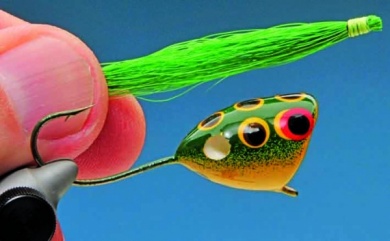The Mc Nally Frog Popper, originally from the 50s, has a special place in my fly boxes because it has never let me down. It is easy to cast and, because of the shape of its legs, it swims and moves the water in a great way. The best wolf fish strikes I’ve had happened because of this popper; it ha View more...The Mc Nally Frog Popper, originally from the 50s, has a special place in my fly boxes because it has never let me down. It is easy to cast and, because of the shape of its legs, it swims and moves the water in a great way. The best wolf fish strikes I’ve had happened because of this popper; it has all the characteristics of a classic, that’s why its effectiveness is timeless.Generally, I prefer using cork because it makes the floating almost as good as with balsa wood, and also resists the bites pretty well. Modern polystyrene bodies are good and practical, for we won’t have to spend time filling the holes in the cork. To paint them, synthetic enamel or aeromodelling paint are good to finish the fly. A fine layer of epoxy makes them more durable as well, but this has to be very fine so the surface action of the fly is correct. Try the Mc Nally Frog Popper, you will be surprised with the results.
Move the mouse over the image to zoom in the fly.
Touch the image to zoom in the fly.

List of materials
Tying MaterialsBody: Short conic popper head.Hook: popper hook preferably, with double back in the middle so it does not turn.Legs: American whitetail deer hair.Thread: 6/0 or 8/0 for the legs, better if it matches the legs.Paint: preferably synthetic enamel.Last layer of epoxy: 30 minute drying epoxy or the one used for rod building.
Steps
Step 1
The polystyrene body is already placed on the hook. Its bend this way so itdoes not tangle with vegetation. Curve the hook downwards right where thepopper body ends, so it swims better. You can see a cork head as well in thepicture, in case you get or make one.
Step 2
Once the hook was cemented with 5 minuteepoxy and dried, paint a couple of times, matte white color. The top head inthe picture is already painted.
Step 3
Firstly, paint the head yellow. Once dry, spray paint the back with abritish-green color. Let it dry. Make thespots, I use nails for this, with different head sizes with flat ends. Carefully use the head to make the spots.
Step 4
I usuallytie a dozen poppers at once. Each painting takes 8 hours to dry, so it takes 3days to make the heads with its different colours and spots. Eyes have two orthree colours.
Step 5
Make a hole at each side with a drill tip,the size of a nail. The hole must have the inclination that the legs will have,a bit to the back.The hair bundles make the legs, its lengthshould be according to the size of the fly.
Step 6
Even the hair and tie it. You can use glue first if you have problems making the knot.
Step 7
Put some 5 minute epoxy in the hole and in the hair tips. The holes must be deep enough to cover the tying on the hair. It’s best to make both legs and tie them at the same time.
Step 8
Once the legs are glued, we can apply a fine layer of 30 minute epoxy to finish the fly perfectly.







